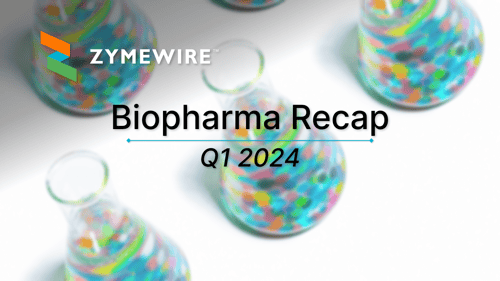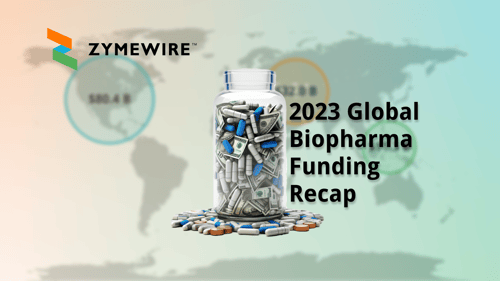Why Your Cold Outreach to Biotechs (Still) isn't Working: A Battle with AI
March 06, 2024 | Alec de la Durantaye |
Industry Articles, Sales
Goals & Hurdles
When it comes to cold outreach in the B2B context, one thing is certain: Email is still the dominant channel. Sound familiar? That’s because we published our first cold outreach article with a similar sentiment.
Today, if you were to tell us that email remains the dominant channel of cold outreach, we would agree. That is, if by “dominant” you mean the most commonly used. Whether or not it’s the most effective channel is up for debate. We believe the most effective cold outreach strategies operate on a multi-channel approach.
Reflecting on that article in 2024, many themes still apply.
- All of our inboxes are still flooded with automated marketing and sales emails, if anything, more so than last year.
- Automated & artificially "personalized" outreach is still easy to sniff out.
- Sellers are still crafting messaging that revolves around their products and services.
- Cold outreach involves reaching out to strangers... Strangers don't trust you.
Let’s take a step back and think about why you’ve implemented a cold outreach strategy in the first place. Chances are it boils down to one (or both) of the following:
- You want your organization to grow faster than it currently is
- You want to generate more predictability in your lead generation
At its core, cold outreach usually presents us with 3 distinct hurdles:
- You need a way to get in touch with the prospect
- You contact the prospect, but they don't respond
- You get the prospect's attention, but they aren't interested
To start, we'll address each of these hurdles individually to help you overcome them.
Multi-Channel Outreach
We polled LinkedIn, asking “What is your go-to cold outreach channel?”. Our friend Melissa quickly made a very important remark:
“Preferred - AND where do you get responses? I don’t see as many responses on LinkedIn because people get bombarded every day with cold outreach… Pro-tip, if you’re using LinkedIn but not networking on it at the same time, you’re doing it wrong”
The channel will only be as effective as the outreach strategy deployed. Think of a kitchen full of the freshest ingredients and the finest pots, pans & knives. Despite having all the right items to cook the perfect dish, if they aren’t used in the right manner then the final product will be inedible.
If the channel is the pan, the ingredients are the insights plus information you’ve gathered on the prospect and their company…making you the chef! With cold outreach, the ingredients should change with almost every message for them to resonate with your prospects. You wouldn’t serve steak to a vegetarian, would you? In another recent poll on LinkedIn, 20% of voters struggle to find the means to contact their prospects. Here are a few tips (excluding Zymewire 😉):
- Send blank connection requests on LinkedIn. Why blank? Because pointing out that you live in the same state, or that you're always looking to connect with "like-minded" people in the industry is the easiest way to have your request denied.
- Apollo.io has a free plan that gives you virtually unlimited access to emails and phone numbers if you prefer those channels.
- Avoid relying on outdated email lists from sources lacking the industry-specific insights that are necessary for your outreach.
Precision Over Volume: Ditch the "Spray & Pray" Method
To be successful as a service provider to biotech & pharma companies, your service model likely isn’t portrayed as a one-size-fits-all solution. A lack of differentiation in your offering will only cause you to blend in with the competition when you should be striving to stand out. Shouldn’t your outreach also stand out?
In an industry where precision and bespoke solutions are prized, it makes little sense to convey identical messaging to potential customers when the services themselves will be inherently diverse and tailored to individual needs.
When crafting your cold outreach strategy, consider the following three assumptions about your recipients:
- They're busy
- They're smart
- They don't trust you
If you don’t believe me, just take a few moments as you clear your inbox in the morning. What’s going through your head? What stands out? Most of us hit the delete button without thinking, pausing on occasion when we see a name we recognize. Constantly bombarded with generic emails sent to a broad audience, our attention spans have dwindled. These messages fail to resonate because they overlook the unique interests and challenges of individual recipients.
While mass email campaigns may not be ideal for building relationships with strangers, they still hold some value. They serve as an effective tool for generating awareness in a fresh market or for a novel product/service – a process often referred to as “warming leads”. Leveraging campaign analytics can inform and streamline your targeted outreach. Keeping in mind what we’ve touched on up to now, a poorly executed follow-up message has the potential to swiftly cool a warm lead.
Here are a few tips & tricks to help you grab the attention of your prospects:
- Any automated email software can add the recipient's name to a subject line, that won't fool anyone. Instead, try mentioning one of their colleague's that they likely work alongside.
- Refer to a recent piece of news about the organization they work for. Whether it be the receipt of funding, a rebranding, the opening of a new facility, or even the latest shareholders report.
- If the company has had a recent setback that you can assist with, offer guidance (without trying to sell your solution off the bat, they don't trust you, remember?).
- Highlight something that they've recently gone through. It can be as simple as a job change, a promotion, or even a conference they attended.
- Inform them of a regulatory change that may impact their business.
As a closing note on the “Spray ‘n Pray” approach, email providers like Yahoo and Google have implemented changes to their services to protect user inboxes.
Building Bridges Through Value
A lot has happened in the last few years to cause a shift in our behaviors, especially how we interact with each other. Communication went entirely remote very suddenly, and the various channels we’ve discussed became overloaded. Since then, we simply don’t answer our phones & emails like we used to.
Unfortunately for us, this means it’s harder than ever to get our prospects to open our messages, so when they do click through to read further, we want to make the most of that exceedingly rare opportunity. Here’s where trust-building comes into play.
Why is it important to build trust early on in the biotech & pharma industry?
- Complex Decision-Making: Products and services being offered often involve high-stakes and significant investments
- Lengthy Sales Cycles: The decision-making process often extends beyond several months. Trust is like the glue that will ensure the conversation progresses smoothly.
- Technical Expertise: Demonstrating an in-depth understanding of the intricacies & regulations within our space enhances your credibility, helping to solidify your position as a knowledgeable and reliable partner.
- Risk Mitigation: Your prospects are constantly weighing the risks of their decisions to chart the best course forward. Trust is a risk mitigator -- reassuring decision-makers that they're dealing with a dependable organization, ultimately reducing perceived risks associated with the partnership.
The best way to establish trust is by providing value upfront. A very common misstep is telling prospects about the value you could provide rather than showcasing it.
Here’s an example that’s been landing in my inbox like clockwork:

A great example of what not to do if you’re trying to establish trust. Why’s that? Well, if they really recorded a video for me, why not share it right away? Because the video doesn’t exist. The strategy here is to send this email to a sea of people, and record videos for those who reply.
Another relatable example is sellers sharing case studies or ROI-based statistics, which may help build credibility but won’t necessarily establish trust unless done properly. If you’re taking this approach, make sure to check these boxes:
- If you’re mentioning clients (testimonials, case studies, etc.), be sure that there is a significant overlap between the client’s business and the business of the recipient. The absence of relevant similarities between the two won’t allow the message to resonate like you intended it to.
- ROI-based messaging works when it relates to a particular pain that your prospect is experiencing. Surface that pain by implicitly referring to it alongside the relevant ROI statement.
Example: You’re putting together a message for a prospective client, and you noticed they had a clinical trial that experienced some delays. You refer to that trial while attaching a case study that discusses how you helped accelerate drug development timelines to meet key milestones ahead of, or on schedule.
Before diving into the Cold Outreach Face-Off, let’s review what we’ve discussed thus far by circling back to the three challenges we highlighted:
- Getting in Touch: While the channel you chose for your cold outreach is important, it should not be a rate-limiting step given the (free and paid) resources we have at our disposal. Adopt a multi-channel approach and focus your energy on the message itself.
- Generating a Response: In an industry where professionals are inundated with messages daily, standing out is essential. Providing valuable insights, referencing recent events or developments, and demonstrating an understanding of your prospects’ challenges are effective strategies for catching their attention.
- Building Interest & Trust: Once you’ve caught their attention, the next order of business is building trust, which is paramount in an environment filled with complex decision-making processes and lengthy sales cycles. Showcasing relevant case studies, demonstrating technical expertise, and providing upfront value are all ways to establish credibility and mitigate the perceived risks associated with new partnerships.
By addressing these problems through thoughtful and personalized outreach, you can increase your chances of engaging prospects and creating valuable relationships with pharma and biotech companies.
Cold Outreach Face-Off
The rapidly growing use of artificial intelligence has added another dimension to the world of cold outreach and is certainly a tool worth exploring, but to what extent?
While the technology is beyond impressive, tools like ChatGPT are known to make mistakes, especially when it comes to healthcare. Are you willing to let some of these mistakes leak into your cold outreach attempts?
To explore further, we’ve put together a challenge, the rules are simple:
- I’ll go head-to-head with ChatGPT
- Both “Participants” will have the same context about the prospect
- Both “Participants” will be writing from the perspective of a (hypothetical) small, biologics-focused CDMO (NoSpam Biologics)
- Both are capable of browsing the internet
- Here is the press release (signal) prompting the cold outreach
- The organization we'll be reaching out to is Attovia Therapeutics
To promote unbiased reactions, we’ll start by showing the two examples side by side. Afterward, you can continue reading to find the prompt, the context, and the reveal of the respective authors.
Message #1
Hi [Name],
I hope the new year is off to a good start for you and the entire Attovia team. Judging by the recent Series A news, I’m willing to bet spirits are high, congratulations!
After a slow funding year for biotech, Attovia is in a position to continue pressing forward as others simply try to stay afloat. Since you’re approaching clinical trials for the first time (with ATTO-1310), I thought I’d share a few timely insights, having accompanied several biotechs through this journey before.
The first thing to consider is a shift from liquid cell culture media to a dehydrated one. While liquid cell cultures are great for preclinical development, they can present logistical hurdles when it comes time to scale up. With recent advancements in technology, this will benefit manufacturing speed without sacrificing quality.
If you’re considering a manufacturing partner, you’ll want to be sure that they have multiple suppliers of raw materials to avoid any delays or logistical nightmares.
Lastly, you’re likely getting to the stage where regulatory & compliance requirements are ramping up, happy to shed light on that front as well. I hope this helps!
Cheers,
Alec
Director of Partnerships - NoSpam Biologics
Message #2
Hi [Name],
I hope this message finds you well. I came across the exciting news about Attovia Therapeutics and couldn't help but reach out. Congratulations on the recent closing of the $30 million second tranche of your Series A financing and the nomination of ATTO-1310 – it's truly remarkable progress!
As a leading biologics-focused CDMO, we're passionate about collaborating with innovative biotech companies like Attovia to bring groundbreaking therapies to market. Your pioneering work in spatially optimized biparatopic biologics aligns perfectly with our expertise and capabilities.
We understand the unique challenges and opportunities involved in advancing novel biologics through clinical development. With our proven track record and state-of-the-art facilities, we're confident that we can add significant value to your development efforts.
Whether it's streamlining manufacturing processes, optimizing product quality, or navigating regulatory requirements, we're here to support you every step of the way. Together, we can accelerate the development of ATTO-1310 and other promising candidates in your pipeline.
I'd love the opportunity to discuss how our partnership can drive success for Attovia Therapeutics. When would be a convenient time for you to connect for a brief discussion?
Cheers,
Alec
Director of Partnerships - NoSpam Biologics
Review
Let’s start by pointing out some differences between the two messages.
Tone and Personalization:
Message 1 adopts a more casual tone throughout the message. The sender refers to the Series A funding and adds context in terms of the advantage it poses given the current climate in the industry. The message also acknowledges that Attovia has yet to reach the clinic, along with the lead asset.
Message 2 maintains a more professional tone. This message also refers to the Series A and lead asset but does not add any additional context or implications.
Expertise and Capabilities:
Message 2 puts a strong emphasis on the role CDMOs play at this stage of development, aligning with the recipient’s work. It also makes a specific value proposition by mentioning accelerated development timelines.
Message 1 takes a different approach by providing tips and insights relevant to the recipient’s current stage of development based on previous experience, rather than highlighting CDMO capabilities.
Call to Action (CTA):
Message 2 includes a clear call to action by inviting the prospect to discuss the possibility of a discussion, putting forward a specified next step.
Message 1 does not include a clear call to action. While it provides valuable insights and offers further assistance, it doesn’t explicitly ask for a follow-up or propose a specific action to take.
Length and Detail:
Message 1 is slightly shorter, offering timely insights & suggestions straightforwardly.
Message 2 is longer, including more detail related to CDMO capabilities, ultimately offering a broader overview of potential areas of collaboration and support.
Who Wrote It?
Now to wrap it all up, let’s reveal who’s who. The message written by me is #1, and ChatGPT wrote message #2. You can find the prompt that was fed to the Large Language Model (LLM) to generate this response below.
“Using this press release from Attovia Therapeutics, and any other available information, I need you to craft a cold outreach message from the perspective of a hypothetical biologics-focused CDMO (NoSpam Biologics) with the end goal being to land them as a client. Your approach should be friendly and informative, with a secondary goal of leaving the prospect with some sort of value. [Insert Press Release]”
The purpose of this exercise was not to determine if humans can still beat out artificial intelligence when writing cold outreach. Whether it’s a meticulously written message you put together yourself, or a prompted response from ChatGPT, the impact lies in the starting point: a relevant and recent signal from a biotech or pharma company. While ChatGPT’s capabilities are impressive, the output hinges on providing it with clear and thoughtful prompts that guide its responses.
With the right foundation, both avenues can yield engaging messages that resonate with your audience to help drive meaningful connections.







Comments